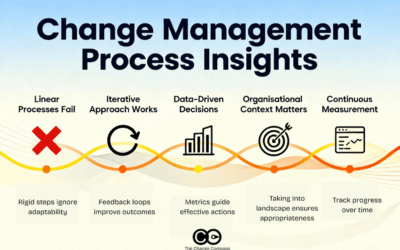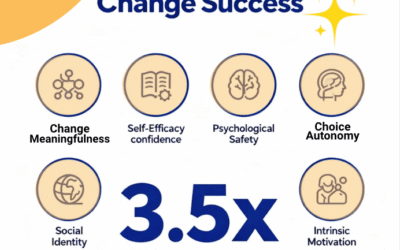Change is an inevitable part of, not just corporate life and business processes, but life in general. It’s a natural occurrence that we all must face at some point. But despite the many benefits that organizational change can bring, many of us are still reluctant to embrace it. After all, for many, it is easier to keep doing the same thing than to do something different and unknown. With the unknown comes risks of disruption and a desire for consistency. Risks that may be scary. Risks that things may be worse than the current scenario.
Often resistance to change can be thought of as an outcome of bad change management. If you don’t effectively manage your stakeholders or have not effectively assessed the impact of change, there are likely going to be common reasons for root causes of resistance for change resistance, including a lack of confidence among stakeholders. Resistance may arise from bad change interventions, including ineffective consultation or engagement of stakeholders.
However, sometimes despite everything you’ve done. You’ve ticked every box and followed almost a ‘textbook’ approach to the change process. Despite this, you are still getting change resistance from some stakeholder groups. Why is this happening?
Sometimes there may be very few levers you can pull in preventing the resistance. You’ve gotten your leadership cohorts to reinforce and evangelize the purpose and benefits of the change. You’ve tried all you can to reach the hearts not just the minds of what you think impacted employees want to hear.
Why is this happening? It could be the fear of failure or loss aversion that has led to the resistance. This is the research-backed fact that people tend to have a cognitive bias where the pain of losing is much stronger than the pleasure of gaining.
One example of this phenomenon is why people stay in bad marriages. Despite the obvious benefits of leaving an unhappy marriage, many people still choose to stay in it. This is because they fear the loss of familiarity, comfort, and security that their marriage provides. This is despite how unhappy they honestly are in the marriage. They may also be afraid of the unknown or the changes that come with divorce. These same fears and reluctance to change can also be seen in organizations and their team members facing change.
For something less dramatic, another example could be changing phones. We are wedded to our phones for a big chunk of how we run our lives. Changing a phone operating system, brand, or even model can be a quite a change that a lot of people are not inclined to go through, until they are pushed to do it.

When organizations decide to implement successful changes, they often focus on the potential benefits that will come from the change, including the introduction of a new product line. They may present a logical argument for why the change is necessary and how it will benefit everyone involved. However, even with a clear and logical argument, people may still be reluctant to embrace change. This is because change often means loss, even if it is the loss of something negative or unwanted.
For example, if an organization decides to implement new software, employee resistance may occur even if it will make their jobs easier and more efficient. This is because they are comfortable with the current system, and they fear the unknown as a significant cause of resistance, or the potential loss of job security and skills that they have developed with the current system. They may also fear that the new system will require them to learn new skills or take on new responsibilities, stemming from their fear of the unknown. This can be despite your best efforts to create a positive picture of the end state.
There are still lots of examples in organisations where employees prefer to stick to their current manual ways of work using spreadsheets, versus the more efficient and effective digital tools.
They may have created the spreadsheet themselves. They may have spent months building consensus across the organisation to use this process. Changing this process could mean not only a lack of familiarity, but it could also result in a loss of their ‘importance’ of their role. So as a result, people continue to maintain the status quo. Stay within the comfort zone. After all, if they don’t change, they can’t be ‘blamed’ if something goes wrong.
As change practitioners, we cannot just blame those impacted by the change. We may also need to see if this applies to us. For example, a lot of change practitioners still use manual spreadsheets to create a ‘single view of change’ despite the amount of manual work that is required. They may have faced leaders who question the integrity of the rating system or become ‘bored’ with the same heatmap or chart since they can’t use it to make black-and-white business decisions. But, fear of the unfamiliarity dominates.

Organizations need to recognize this fear of loss and work to address it in line with their organizational goals, as clarity is essential in managing change. Here are some practical suggestions for designing change initiatives that can help tackle this barrier:
1. Look at the data about how your target employees have responded to different types of changes in the past. What types of responses were there with a certain type or volume of change? How were these dealt with? What were the outcomes? What types of employees were more ‘resistant’ than others?
2. Communicate Clearly, Early and Transparently: Slow change adopters may need more time to prepare for change and what it means for them. Involving key stakeholders as part of the communication process can clarify available options if they do not like the end state. What if they disagree? Communication should be clear, transparent, and empathetic. It should focus on the benefits of the change, and address any concerns or fears employees may have. It should also focus on what would happen if the changes are not adopted.
3. Involve employees in the Change Process (where it makes sense): Inviting employees to participate in the change process can help them feel more invested in the change and less fearful of losing control. When employees have a voice in the decision-making process, they are more likely to feel valued and respected. This also allows businesses to identify potential challenges and concerns that employees may have, which can be addressed before the change is implemented. In addition, setting key metrics can help in evaluating the effectiveness of this approach. This approach may need to be applied carefully, especially when dealing with a highly resistant group of employees. If not carefully managed, the change approach may get out of control.
4. Provide Support: Change can be overwhelming and stressful, especially when employees feel like they are not equipped to handle it. Providing support and training can help employees feel more confident and prepared for the change effort. It can also help them see the benefits of the change more clearly. This may sound like common sense. But it’s amazing how many change initiatives don’t provide any support to impacted groups, beyond technical support.
5. Celebrate Successes: Change can be a long and difficult process, so it is essential to celebrate successes in a timely manner along the way. Recognizing and acknowledging employee efforts and successes can help maintain momentum and motivation. This is another seemingly ‘no-brainer’. Designing a series of successes helps create positivity.
6. Be Patient: Change takes time, and employees need time to adjust. It is essential to be patient and understanding. Rushing the process or ignoring employees’ concerns can lead to resistance and resentment. In your change readiness assessment or strategic plan during the baselining phase of the project, if you’ve found that change adoption could be slow and resistance could be expected, ensure you’ve factored in sufficient timing.
Change is difficult, even when it makes logical sense and has many benefits. People are often afraid of losing something, even if it is something negative or unwanted, which can lead to discomfort. Organizations need to recognize this fear of loss and work to address it when implementing changes. Recognising this cognitive bias is the first step. By providing support, and resources, and involving employees in the change process, organizations can help reduce the fear of loss and successfully implement change.






